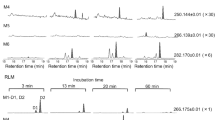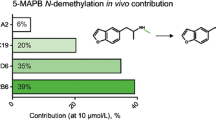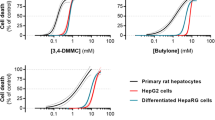Abstract
Some major metabolic pathways of 3,4-methylenedioxymethamphetamine (MDMA) have been shown to be dependent on cytochrome P450 (CYP) isozymes by in vitro studies. The aim of this study was to clarify the roles of these CYP enzymes for in vivo metabolism of MDMA with respect to two pathways using rats: N-demethylation of MDMA to 3,4-methylenedioxyamphetamine (MDA) and O-demethylenation of MDMA to 3,4-dihydroxymethamphetamine (HHMA)followed by O-methylation to 4-hydroxy-3-methoxymethamphetamine (HMMA). Rats were pretreated with phenobarbital (PB, 80 mg/kg i.p.) or β-naphthoflavone (BNF, 80 mg/kg i.p.) once a day for 3 days before administration of MDMA (10 mg/kg i.p.). Metabolic changes were monitored by measuring the urinary excretion of MDMA and its metabolites. Twenty-four hours after MDMA administration, MDA in rat urine was significantly decreased by 43% and 70%, and HMMA was significantly increased by 33% and 64% in urine samples from PB-pretreated and BNF-pretreated rats, respectively, as compared with the control values. Testosterone 6β-hydroxylase (CYP3A), pentoxyresorufin O-dealkylase (CYP2B1), ethoxyresorufin O-deethylase (CYP1A1), and methoxyresorufin O-demethylase (CYP1A2) activities were increased 2–6 fold in both PB-pretreated and BNF-pretreated rat liver microsomes sampled at 24 h after MDMA administration as compared with the control values. These results suggest that PB-induced and BNF-induced CYP enzymes have inhibitory effects on N-demethylation of MDMA to MDA in vivo in rats. If HHMA is the precursor of HMMA in rats, there is a possibility that the O-demethylenation of MDMA to HHMA is increased by the induced CYP enzymes. The decreased urinary concentration of MDMA and very low percent recoveries of MDA, HMMA, and (4-hydroxy-3-methoxyphenyl)acetone (HMPA) in the inducer-pretreated groups suggest that other metabolic pathways of MDMA exist and are activated under the present experimental conditions.
Similar content being viewed by others
References
Monks TJ, Jones DC, Bai F, Lau SS (2004) The role of metabolism in 3,4-(±)-methylenedioxyamphetamine and 3,4-(±)-methylenedioxymethamphetamine (Ecstasy) toxicity. Ther Drug Monit 26:132–135
Montiel-Duarte C, Varela-Rey M-P, Oses-Prieto JA, Lopz-Zabalza MJ, Beitia G, Cenarruzabeitia E, Iraburu MJ (2002) 3,4-Methylenedioxymethamphetamine (“Ecstasy”) induces apoptosis of cultured rat liver cells. Biochim Biophys Acta 1588:26–32
Liu RH, Liu H-C, Lin D-L (2006) Distribution of methylenedioxymethamphetamine (MDMA) and methylenedioxyamphetamine (MDA) in postmortem and antemortem specimens. J Anal Toxicol 30:545–550
Coutts RT, Su P, Baker GB (1994) Involvement of CYP2D6, CYP3A4, and other cytochrome P-450 isozymes in N-dealkylation reactions. J Pharmacol Method 31:177–186
Lim HK, Foltz RL (1988) In vivo and in vitro metabolism of 3,4-(methylenedioxy)methamphetamine in the rat: identification of metabolites using an ion trap detector. Chem Res Toxicol 1:370–378
Lim HK, Folz RL (1991) In vivo formation of aromatic hydroxylated metabolites of 3,4-(methylenedioxy) methamphetamine in the rat: identification by ion trap tandem mass spectrometric (MS/MS and MS/MS/MS) techniques. Biol Mass Spectrom 20:677–686
Green AR, Mechan AO, Elliott JM, O’shea E, Colado MI (2003) The pharmacology and clinical pharmacology of 3,4-methylenedioxymethamphetamine (MDMA, “Ecstasy”). Pharmacol Rev 55:463–508
Pirnay SO, Abraham TT, Lowe RH, Huestis MA (2006) Selection and optimization of hydrolysis conditions for the quantification of urinary metabolites of MDMA. J Anal Toxicol 30:563–569
de la Torre R, Farre M, Ortuno J, Mas M, Brenneisen R, Roset PN, Segura J, Cami J (2000) Non-linear pharmacokinetics of MDMA (“ecstasy”) in humans. Br J Clin Pharmacol 49:104–109
Shima N, Katagi T, Nishikawa M, Miki A, Tsuchihashi H, Sakuma T, Nemoto N (2008) Urinary excretion of the main metabolites of 3,4-methylenedioxymethamphetamine (MDMA), including the sulfate and glucuronide of 4-hydroxy-3-methoxymethamphetamine, in humans and rats. Xenobiotica 38:314–324
Shima N, Kamata HT, Katagi M, Tsuchihashi H, Sakuma T, Nemoto N (2007) Direct determination of glucuronide and sulfate of 4-hydroxy-3-methoxymethamphetamine, the main metabolite of MDMA in human urine. J Chromatogr B 857:123–129
Tam YK, Ke J, Coutts RT, Wyse DG, Gray MR (1990) Quantification of three lidocaine metabolites and their conjugates. Pharm Res 7:504–507
Terada M, Yoshimura S, Yamamoto T, Yoshida T, Kuroiwa Y (1983) Rapid and highly sensitive method for determination of methamphetamine and its metabolites in rat urine by gas chromatography with flame-thermoionic detector. Eisei Kagaku 29:143–153
Katagi M, Tsuchihashi H (2005) 3,4-Methylenedioxyamphetamines. In: Suzuki O, Watanbe K (eds) Drugs and poisons in humans: a handbook of practical analysis. Springer, Berlin Heidelberg New York
Lowry OH, Rosebrough NJ, Farr AL, Randall RJ (1951) Protein measurement with the Folin phenol reagent. J Biol Chem 193:265–275
Omura T, Sato R (1964) The carbon monoxide-binding pigment of liver microsomes I. Evidence for its hemoprotein nature. J Biol Chem 239:2370–2378
van der Hoeven T (1984) Assay of hepatic microsomal testosterone hydroxylases by high-performance liquid chromatography. Anal Biochem 138:57–65
Burk MD, Mayer RT (1974) Ethoxyresorufin: direct fluorimetric assay of a microsomal O-dealkylation which is preferentially inducible by 3-methylcholanthrene. Drug Metab Dispos 2:583–588
Soucek P, Gut I (1992) Review; cytochromes P-450 in rats: structures, functions, properties and relevant human forms. Xenobiotica 22:83–103
Kumagai Y, Lin LY, Hiratsuka A, Narimatsu S, Suzuki T, Yamada H, Oguri K, Yoshimura H, Cho AK (1994) Participation of cytochrome P450-2B and-2D isozymes in the demethylenation of methylenedioxymethamphetamine enantiomers by rats. Mol Pharmacol 45:359–365
de la Torre R, Farre M, Roset PN, Pizarro N, Abanades S, Segura M, Cami J (2004) Human pharmacology of MDMA. Pharmacokinetics, metabolism, and disposition. Ther Drug Monit 26:137–144
Maurer HH, Bickeboeller-Friedrich J, Kraemer T, Peters FT (2000) Toxicokinetics and analytical toxicology of amphetamine-derived designer drugs (Ecstasy). Toxicol Lett 112–113:133–142
Author information
Authors and Affiliations
Corresponding author
Rights and permissions
About this article
Cite this article
Akhter, N., Tanaka, S., Ashino, T. et al. In vivo study on the roles of cytochrome P450 enzymes for metabolism of 3,4-methylenedioxymethamphetamine (Ecstasy) in rats. Forensic Toxicol 26, 52–57 (2008). https://doi.org/10.1007/s11419-008-0051-0
Received:
Accepted:
Published:
Issue Date:
DOI: https://doi.org/10.1007/s11419-008-0051-0




